Sunday, April 30, 2023
9-Year-Old Girl Sexually Assaulted In Delhi, Minor Boy Detained: Cops
Watch: Man Holds On To Bonnet As Car Is Driven For 2-3 Km In Delhi
Anti-Encroachment Drive Begins At Delhi's Tughlaqabad Fort Site
Man Assaults Doctor, Abuses Female Attendant At Mumbai Hospital, Arrested
6 Arrested For Running Kidney Racket In Andhra's Visakhapatnam
Saturday, April 29, 2023
Bihar Woman Dies By Suicide After Killing Her 3 Children, Say Cops
Caught On CCTV: 6 Men Part Of Fresh Strike By Maharashtra's 'Machete Gang'
Man Jumps Off Building To Avoid Arrest In Maharashtra, Dies
E Shinde Meets Hospitalised People Injured In Godown Collapse Near Mumbai
"Chipko" Protest In Pune Against Tree Felling For Riverfront Project
Delhi Cop Killed In Accident On Delhi-Gurugram Expressway
Friday, April 28, 2023
Three-Month-Old Child Dies After Vaccination In Jharkhand: Cops
Several Charged In Aligarh For Offering Namaz Outside Mosques On Eid
4 Killed After Truck Crashes Into Tractor In Rajasthan's Pali District
How to create a resource page
If you’re interested in creating helpful content for your audience (and you should be), you should consider making a resource page.
It’s the best way to collect your top recommendations for products or services and promote the tools and resources you love and use in your business.
And as part of your content strategy, a resource page can add depth and value to your website.
Let’s go deeper into what a resource page is, why you should create one, and how to do it, plus resource page examples.
What is a resource page?
A resource page is a curated page that links to helpful resources, tools, apps, products, services, media, or websites that your audience may find useful.
(You may also know this page as a “recommended tools” page, an affiliate links page, or even a brand “toolbox.”)
A resource page is a one-stop shop for finding a brand’s recommended resources, including the tools or products its staff uses and loves in the company’s day-to-day business.
If you’re a solopreneur or freelancer, your resource page can be very personal and reflect your expertise. And, if you’ve built a following and an engaged audience, your resource page will be valuable for the people who trust your guidance.
There are three ways to approach a resource page:
- Use affiliate links. (This means you and the company of the product you recommend have an agreement – you earn a small commission from people who click your affiliate link and engage with that company.)
- Link to resources organically (because you love them and for no other reason).
- Include a mixture of affiliate and organic links.
Why you should create a resource page
The first and most important reason to create a resource page is the helpfulness factor.
- A resource page curated by you can help your audience discover tools, websites, and resources to help them solve problems they face.
- The resource page you create can be personalized with hand-picked links that you actually use, enjoy, or get value from – and since your expert opinion matters to your audience, they’ll care about the resources you recommend.
The second reason to create a resource page is if you’re involved with affiliate programs and want to maximize your income.
Including your links on a dedicated resource page in your top navigation gives your readers an easy way to find and engage with them.
But, remember – never create a resource page just to get people to click your affiliate links.
Instead, create this type of content to help your audience connect with great resources that have aided you during your own journey in your niche.
How to create a resource page with value
Anyone can throw together a list of links. To avoid the plague of thin, useless content, follow these steps to create a resource page with real value for your readers.
1. Gather links to your most trusted resources for your niche
This initial step in creating a resource page should be the easiest.
You simply need to gather a list of links to your favorite, most trusted tools, websites, products, services, etc. that relate to what you do in your niche.
For example, if you’re an expert baker who posts recipes, your resource page might be full of the baking tools you trust and use daily, like on this baking website:
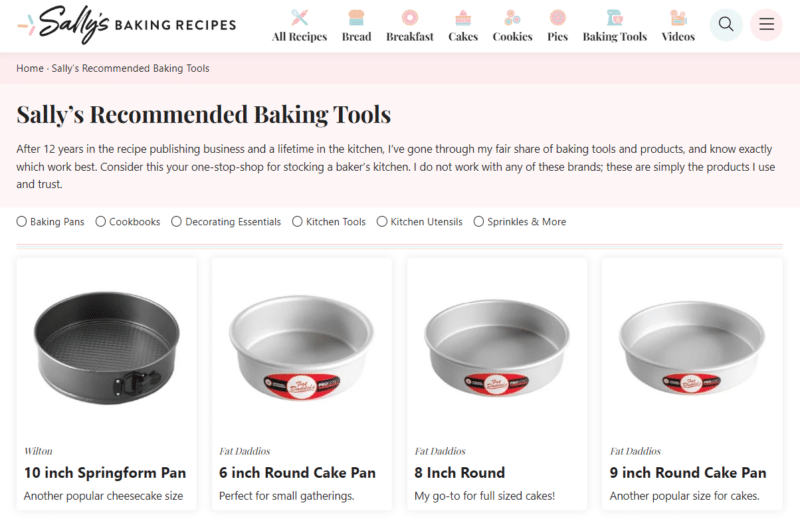
Similarly, if you sell content marketing courses, your resource page would likely include a list of tools you use to make content marketing easier.
(Think SEO tools, content creation tools, your favorite website host, and the content calendar tool you depend on.)
Don’t include just any resources. Think about what would be most beneficial for your audience.
Finally, never recommend anything you haven’t actually used or liked. Honesty and transparency are essential for maintaining the trust between you and your audience.
2. Including affiliate links? Add a disclosure
If you plan to include affiliate links on your resource page, add a clear disclosure that you may earn a commission when your visitors click those links.
This isn’t just good practice for ethics and transparency – it’s also a requirement of the U.S. Federal Trade Commission (FTC).
The FTC considers linking to affiliate sites without disclosure to be deceptive advertising.
Luckily, the disclosure itself doesn’t have to be a big deal. A simple, clear statement at the top of your page will suffice. Here’s a great example from a photography website:
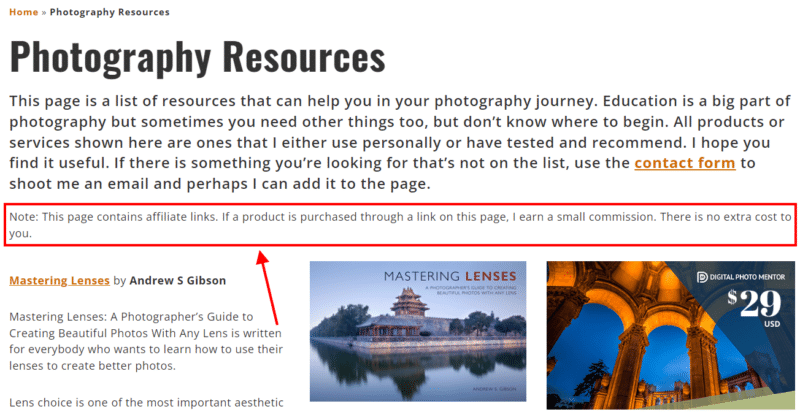
3. Describe each resource and why you included it
Now we can start beefing up your resource page with useful content.
What will make your page useful beyond the links themselves?
Helpful descriptions that explain why you're recommending each product, service, tool, etc., and why they're valuable.
Here's a good formula for describing the resources on your page:
- Introduce the product/service/tool/resource and explain what it does.
- Explain why you use it and trust it.
- List at least one way it could improve your reader's life.
Your descriptions don't have to be long, either. You can summarize each of the above points in one or two sentences. Here's an example from Smart Passive Income:
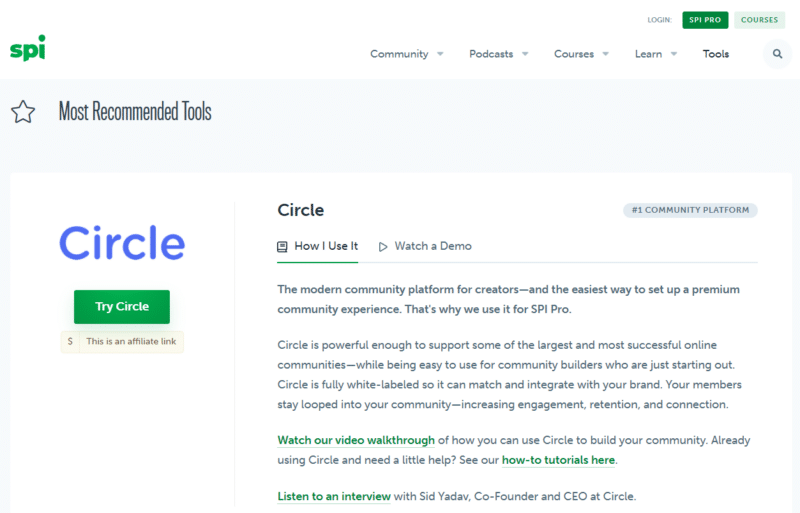
Ultimately, this list of recommended tools is much more valuable because SPI describes how and why each tool is trustworthy and effective.
If, on the other hand, they just provided a list of links, you wouldn't understand the value of any of them.
4. Organize and optimize your resource page
Again, don't just throw a list of links on a page. Put some effort into organizing and optimizing your resource page so the most visitors will get the most use out of it.
Particularly, organize your resources into categories and add a heading (an H2 or an H3) to each one.
For example, if you have a list of media to consume to learn more about a topic, you could categorize the links by type of media, e.g., books, podcasts, videos, blog posts, courses, etc.
This wellness center, for instance, has a resource page for employees and their families that includes online fitness resources categorized by workout type:
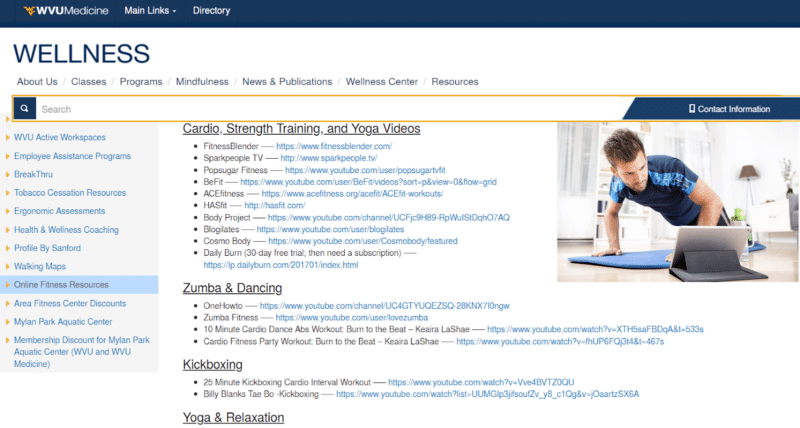
Another option: If you regularly blog about great industry resources, collect them on one resource page, like Learn to Code With Me did:

5. Link to relevant content on your site
Yes, you can include your own content on your resource page, but take care – adding too much of your content can look a bit too self-promotional.
Instead, look for ways to mention or link to your content organically.
For instance, this travel blog includes their in-house tour company as one of the resources under their “tour companies” category.
However, the mention isn't overtly salesy and looks even less so next to their other recommendations.

Another way to include your content on your resource page is to link to related blog posts.
Add these links in the descriptions for each category, such as, "Want to learn more about choosing a travel company? Check out our guide.”
6. Update your resource page regularly
Next, since your resource page is essentially a page full of links, you'll want to make sure the links are working and accurate regularly.
For example, this can be a task you set as part of your regular website or content audit.
A quick way to check all the URLs on the page for dead links is to use a broken link checker.
Lastly, ensure your affiliate links are all accurate and working so it's tracked each time someone is referred through your page to a product.
7. Link to your resource page in your other content
Once your resource page is created, link to it in your other content, including blogs and core site pages like your About Us page.
For example, a baking blog could link to its resources page whenever they talk about baking equipment. E.g., “The right size mixing bowl is essential to creating this recipe. Check out my resource page to see the large mixing bowls I use and love.”
Essentially, any “learn more” opportunity or mention in a blog could connect back to your resource page.
Of course, another great place to include a link to this content is right in your main menu. Learn to Code With Me does this well – its resource hub is located in the top menu under the heading “Where to learn.”
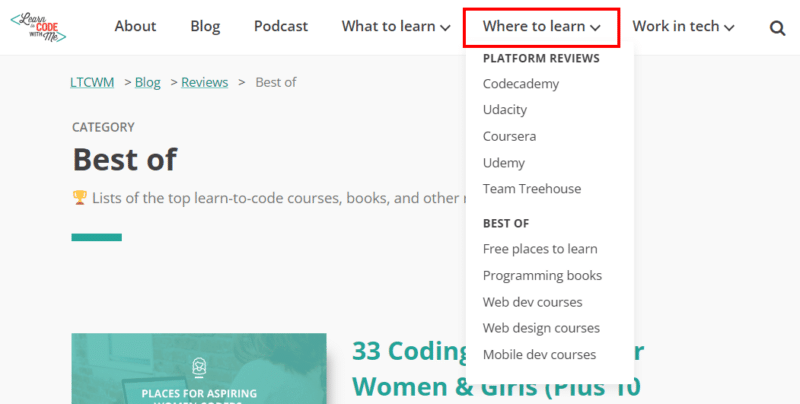
Those aren't the only possibilities. Here are some other suggestions for linking to your resource page in your other content:
- Include a link in your site's footer menu.
- Create a call-to-action banner or graphic to place strategically inside blogs.
- Add a link to your lead magnets, ebooks, or freebies.
- Create a perpetual link for your blog sidebar.
- Link to and promote your resource page in social media posts.
A resource page is helpful content
Correction: A resource page can be helpful content if you create it with the above steps in mind.
And that's important because helpful content matters to your audience as part of their overarching experience of your brand. It also matters to Google, because the search engine wants to serve searchers content that helps them.
As you'll remember, helpful content is:
- Created with a specific audience in mind.
- Has trust and credibility markers.
- Includes expertise from the creator(s).
- Meets the needs of the audience.
Created with care, your resource page can add value to your content strategy by educating your audience and strengthening your website. And those are worthy goals.
The post How to create a resource page appeared first on Search Engine Land.
from Search Engine Land https://ift.tt/m5LbgKM
via https://ift.tt/GVIMogX https://ift.tt/m5LbgKM
Delhi Reported 40 Covid-Linked Deaths Between April 19-27: Data
Water Crisis In Maharashtra's Raigad, Collective Stock In Dams At 35%
Thursday, April 27, 2023
New update to Google’s Dangerous products or services policy
In July 2023, Google Ads will update its Dangerous products and services policy to encompass advertisements for items that pose an imminent, proven, and unresolved risk of death or severe bodily harm, particularly if they have been the subject of consumer advisories or product recalls. Enforcement of this policy update will commence on July 3.
Violations. Accounts found to be in violation of this policy will not face immediate suspension without prior warning. Instead, a warning will be issued at least seven days before any account suspension takes place.
What to do. It is recommended that advertisers review this policy update to determine if any of your ads fall within the scope of this policy. If so, remove the ads in question before July 3, 2023.
Why we care. By proactively reviewing and removing any ads that fall within the scope of this policy, advertisers can maintain their online presence, protect their brand reputation, and continue to reach their target audience effectively.
The post New update to Google’s Dangerous products or services policy appeared first on Search Engine Land.
from Search Engine Land https://ift.tt/IYGoldw
via https://ift.tt/GVIMogX https://ift.tt/IYGoldw
Discover the ultimate marketing strategy for increased ROI and lead generation by Cynthia Ramsaran

Virtual events are great for education, global outreach and strengthening your brand awareness. But what they’re especially fantastic at is lead generation.
In this webinar, you’ll get the perfect cut-and-paste formula for turning your events into lead-generating machines.
Register and attend “Maximize ROI and Lead Gen With This Virtual Events Marketing Formula,” presented by Kaltura.
Click here to view more Search Engine Land webinars.
The post Discover the ultimate marketing strategy for increased ROI and lead generation appeared first on Search Engine Land.
from Search Engine Land https://ift.tt/7PjkByY
via https://ift.tt/GVIMogX https://ift.tt/7PjkByY
Removed Recently From Hindu College Job, Ad-Hoc Teacher Found Dead
Woman Cop Facing Disciplinary Action Found Dead In Her Mumbai Home
Wednesday, April 26, 2023
Watch: Actor Calls Family In Mumbai After Being Freed From Sharjah Jail
Assam Woman Throws Baby Girl Into Pond, Arrested: Cops
Meta’s ad revenue is up 4.3% in Q1
The “year of efficiency” for Meta is starting out relatively decent in terms of revenue, with a 3% increase overall. And despite their plan to cut an additional 10,000 jobs this quarter, things seem to be looking up. At least for now, anyways.
Meta shows growth for advertising and its Family of Apps but a decline in revenue for its other major business segment, Reality Labs. Let’s dive in.
Revenue. Ad revenue increased by about 4.3% in Q1 2023.
- The advertising revenue for Q1 2023 was $28,101 million, an increase of 4.3% compared to the same period in 2022 ($26,998 million).
- Total revenue for Q1 2023 was $28,645 million, an increase of 2.6% compared to the same period in 2022 ($27,908 million).
- Other revenue was $205 million for Q1 2023, a decrease of 5.1% compared to the same period in 2022 ($215 million).
Sure, here is the table with an additional column for the percent difference:
| Q1 2023 (in millions) |
Q1 2022 (in millions) |
Difference | |
|---|---|---|---|
| Advertising | $28,101 | $26,998 | 4.3% |
| Other revenue | $205 | $215 | -5.1% |
| Family of Apps | $28,306 | $27,213 | 3.9% |
| Reality Labs | $339 | $695 | -51.1% |
| Total revenue | $28,645 | $27,908 | 2.6% |
Daily active users. Meta’s Q1 2023 performance also showed impressive growth in user engagement.
- Facebook’s daily active user count increased by 4% to reach 2.04 billion.
- The number of monthly active users was 2.99 billion.
- The “family of apps” category, which includes Instagram and WhatsApp, saw a 5% year-over-year rise in daily active users, totaling 3.02 billion.
- The number of monthly active users in this category also increased by 5% to 3.81 billion.
Good to know. For the full year, analysts are estimating total expenses of $86B-$90B, which includes $3B-$5B of restructuring costs, and expects Reality Labs operating losses to increase this year.
Dig deeper. You can review the full earnings report here.
Why we care. Meta’s financial performance and growth provides important insights into the current state of the technology industry and the advertising market. The earnings report can give advertisers a sense of the overall demand for technology products and services, such as the company’s two main business segments, Family of Apps and Reality Labs, which can help advertisers understand the trends and opportunities in these areas.
The post Meta’s ad revenue is up 4.3% in Q1 appeared first on Search Engine Land.
from Search Engine Land https://ift.tt/WiVI4af
via https://ift.tt/KonSM72 https://ift.tt/WiVI4af
Stop wasting your search budget by Digital Marketing Depot

How are you identifying where you can reduce your marketing costs and increase profitability, without hurting revenue?
If you’re a PPC advertiser, chances are you are throwing money away on brand terms.
“Lone Rangers” are your brand terms that rank #1 in both paid and organic search but have no other
competitors bidding on them. Why pay for those clicks? Some enterprise brands with large paid search investments waste millions each year.
Adthena’s research shows brands can save up to 20% of their PPC budgets annually by eliminating spend on these Lone Rangers.
Don’t let your budget go to waste! Download How to Get 1 in 5 Dollars Back on Brand Search to learn everything you need to know to reduce brand search costs and reinvest in higher-performing search terms.
The post Stop wasting your search budget appeared first on Search Engine Land.
from Search Engine Land https://ift.tt/Lw6mVjR
via https://ift.tt/KonSM72 https://ift.tt/Lw6mVjR
Delhi Reports 7 Covid Deaths, Highest So Far In 2023; 1,040 Fresh Cases
Tuesday, April 25, 2023
Top Delhi School Gets Bomb Threat On Email, Nothing Found So Far
Smuggled Gold Worth Rs 10 Crore Seized At Mumbai Airport;19 Women Arrested
Google search revenue rises 2%, slight dip in total ad revenue
In the first quarter of 2023, Alphabet Inc., the parent company of Google, reported a slight decrease in Advertising revenue, while Search saw an increase of almost 2% YoY.
Overall impressions. Overall, these results suggest a mixed performance for Google’s advertising platforms in terms of ad impressions. Even with all of the layoffs, Google has entered the first quarter of this year with nearly 27,000 more employees than last year. Though, it was noted that “the number of employees includes almost all of the employees affected by the reduction of our workforce. We expect most of those affected will no longer be reflected in our headcount by the end of the second quarter of 2023, subject to local law and consultation requirements.”
Dig deeper. You can read the full report here.
Why we care. Though down slightly, Google is still the main player in the search game. But its momentum seems to be slowing with the increase in Microsoft users, ChatGPT, and advancements from other technology platforms.
The post Google search revenue rises 2%, slight dip in total ad revenue appeared first on Search Engine Land.
from Search Engine Land https://ift.tt/nhxOsfH
via https://ift.tt/ZfD87bC https://ift.tt/nhxOsfH
"Delhi University Is Not Hogwarts": Row Over Rs 5 Lakh Magic Show
Create high-quality content that meets Google E-E-A-T standards by Digital Marketing Depot

Are you struggling with your content marketing strategy? Do you lack time, resources, and a clear purpose? The Content Marketing Quick Start Guide from MoreVisibility is here to help! This guide provides tips and guidance to jumpstart your content planning and creation, helping you overcome common challenges such as lack of time, strategy, or production resources.
One of the most critical aspects of content marketing is Google E-E-A-T, which stands for experience, expertise, authoritativeness, and trustworthiness. In this guide, you’ll learn how to create content that meets these guidelines, ensuring that your website ranks higher in search engine results and drives more traffic to your site.
The guide will walk you through the different types of content you’ll need to plan, create, and optimize. Visit Digital Marketing Depot to download the Content Marketing Quick Start Guide.
The post Create high-quality content that meets Google E-E-A-T standards appeared first on Search Engine Land.
from Search Engine Land https://ift.tt/dS9Ms1v
via https://ift.tt/ZfD87bC https://ift.tt/dS9Ms1v
Mumbai Hotelier Abducted At Gunpoint, Rescued; 7 Arrested: Police
Monday, April 24, 2023
Senior Citizen Dead After Man Jumps On Him In Mumbai Swimming Pool
How to create a guide that is optimized, useful and comprehensive
Guides are all over the web. Google any word + “guide,” and you’ll probably find someone has written about that topic, no matter how obscure.
But there’s a good reason for this: Well-written guides are extremely valuable pieces of content.
When your audience encounters your guide at the right place and time, it can be life-changing. Your guide may be the cornerstone or the turning point in their experience of a particular topic.
You could teach them valuable skills, introduce them to a vital concept, expand their knowledge, or help them understand a complex subject.
As you’d imagine, a good guide can help build a strong trust between a person and a brand.
And trust contributes to the customer experience. It can eventually translate to profitable action like converting a casual reader into a subscribed follower or turning a fan into a customer.
That’s why it’s time to learn how to create optimized, useful, and comprehensive guides – so you, too, can build trust with your audience through high-quality content.
What is a guide?
A guide is a comprehensive piece of content that aims to educate an audience by:
- Introducing them to a topic or subject.
- Teaching them a set of concepts or ideas.
- Walking them through a process to achieve an end goal.
- Showing them the steps to complete an action.
Quite simply, an effective guide will teach you in some way.
But, the best of this content type will meet you at your level of understanding, speak to you in terms you understand, and take you to the next level to broaden your knowledge.
How to create a guide, ultimate-style
1. Understand the knowledge level of your target audience
To write a great guide, you need to understand your audience and know their knowledge level about your topic.
- What do they already know?
- Where are they starting from? (Are they beginners? Intermediates? Experts?)
- What do they not know?
- What are their top challenges?
These points are crucial to understand because you will use them as a benchmark for where your guide will begin and what it will cover.
Not understanding your audience’s knowledge level about your topic will lead to a less useful guide.
For example, starting a guide on baking bread with information about buying mixing bowls will be helpful only to true beginners who don’t have the right equipment yet. It won’t be helpful for baking enthusiasts who have moved beyond acquiring tools.
So, if you’re unsure what your audience knows or doesn’t know about your topic, you’ll need to do some research.
When all else fails, ask them directly. Post a poll or survey on social media, or post a question asking for feedback on what your audience would like to know about X topic.
2. Research and outline your topic
Now it’s time to start drafting your guide.
I always start with an outline and jot down everything I know the guide should include.
Then I research the topic to see what I’m missing, what others have written about it, and any additional tidbits I should add.
For example, even as an expert, you don’t want to rely entirely on your brain for fleshing out a topic.
You may know it well, but you also need to ensure you cover all the key areas readers care about.
Start by researching the topic on Google. Look at what the top articles cover and make sure your guide includes all of those sub-topics, too.
For example, say you’re writing a guide on planting tulips. You discover the guides at the top of Google also include information about when to plant them, how to care for them, and additional tips on varieties and container planting. That means your guide needs to be just as thorough.
When your outline is equally as comprehensive as the top articles in Google, you’re still not done. You need to go further.
Include information guided by your expertise (or the brand’s expertise). That’s the mixture of experience and education that’s unique to you that will differentiate your content from the masses.
- Add insights based on personal experience.
- Add insider knowledge that most people don’t have.
- Include tips, tricks, shortcuts, or advice.
- Include useful information that similar guides are missing.
For instance, in this particular tulip planting guide, the author added information on common pests and fun facts. Similar guides are missing these pieces:
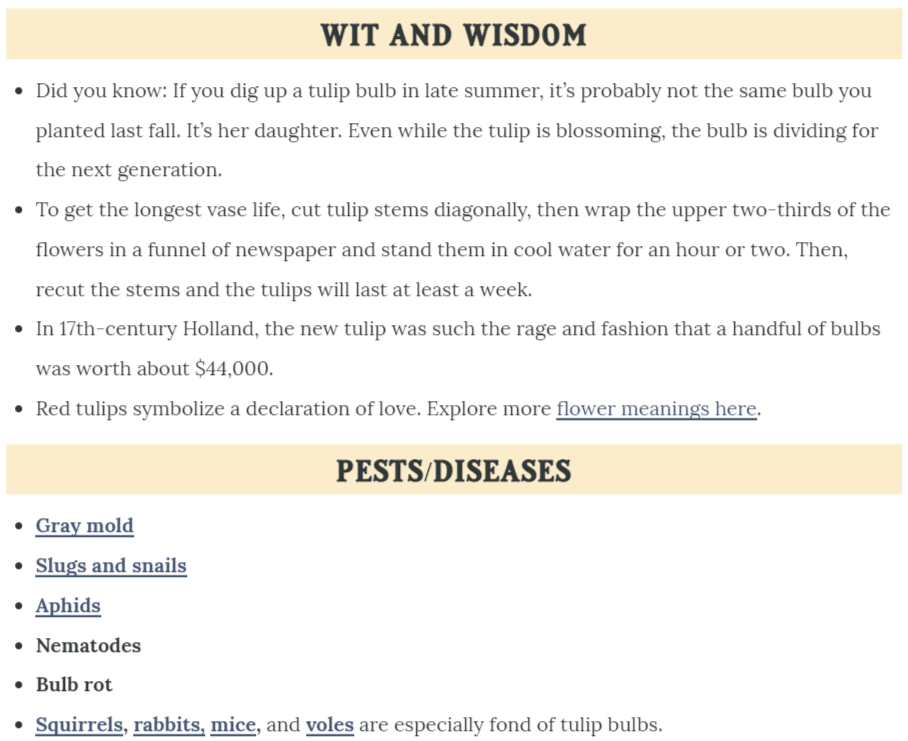
Beyond Google, look at other information sources to flesh out your topic. Research books, look at interviews with experts, or watch videos.
Double-check to ensure you include the most accurate, relevant, and useful details in your guide.
3. Split your guide into sections, organized by sub-topic
At this point, while your draft is still pared down, it’s a good idea to get it organized.
- Split it into sections, with each section covering a specific sub-topic. For example, the tulip planting guide would be split into sections like “when to plant tulips,” “how to plant tulip bulbs,” “how to care for growing tulips,” and “tulip varieties.”
- Order the sections logically. You wouldn’t put “how to care for tulips” above the section on planting tulips, for instance, because one naturally precedes the other. (You can’t care for tulips you haven’t planted yet!)
- If your guide includes any instructions or steps, ensure they’re clear, laid out logically, and easily read. Number each step so readers understand the sequence at a glance.
4. Use keyword-rich headings
The best guides have clearly labeled sections with descriptive headings. This format helps readers find the information they’re looking for without having to hunt through unlabeled paragraphs that all bleed together.
It’s also good for SEO, especially if you include keywords in your section headings.
Here’s an example of a Chicago travel guide that uses clear, keyword-rich headings for each section:
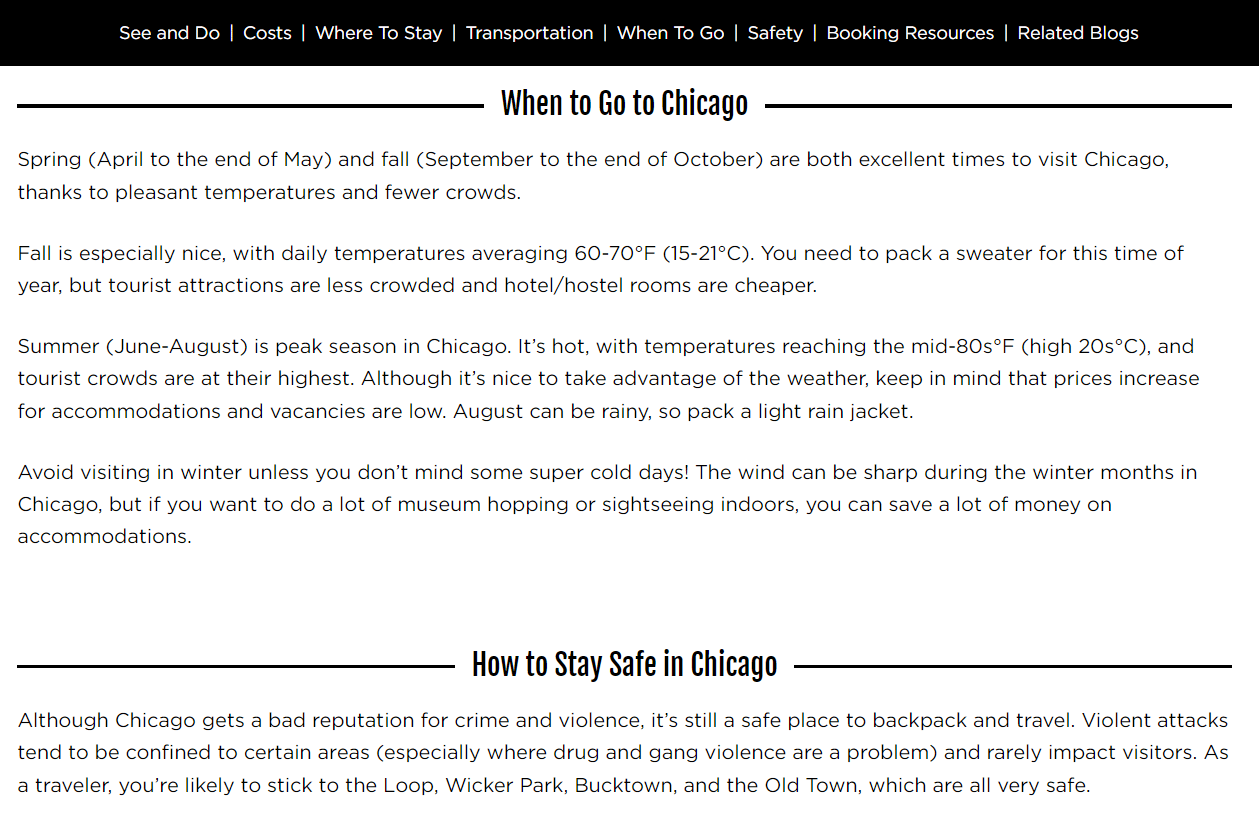
Particularly, note that the keyword “Chicago” is included in each heading.
Imagine if each heading was more generic, like “When to Go” vs. “When to Go to Chicago.” The difference is optimization. The latter heading is optimized – and the former isn’t.
If adding the focus keyword in your section headings doesn’t make sense, consider including related terms and phrases instead. You can find these by entering your main keyword into Semrush or Ahrefs.
At the very least, write headings that help your reader scan your guide and find the necessary information.
5. Go deep
Guides are typically long-form content for a reason. When readers look for a guide on a subject, they expect comprehensiveness.
For that reason, don’t just skim the surface of your topic. Go deep.
That means you should try to include examples, descriptions, comparisons, or definitions in your guide.
- Examples put your subject in context for your readers. It shows them real-world applications of what you’re talking about.
- Descriptions give readers sensory details that can widen their understanding. For instance, you can describe how something looks, feels, tastes, or smells to help your audience imagine it better.
- Comparisons give additional context by comparing things your audience may not be familiar with to things they are familiar with.
- Definitions also lay the groundwork for understanding a topic or difficult concept. Defining these in plain language can set up your reader to get the most out of the rest of your guide.
You may use some of these techniques or all of them – it really depends on your topic.
For example, in a guide about making a complex dessert, you might want to describe how it should look and taste to help your audience understand a successful end product.
Similarly, in a guide about bird-watching, you could help your audience identify a particular bird species by comparing it to a similar species and noting the key differences.
Explaining a subject well is an art form, so take the time to get it right to create the most useful guide possible for your particular audience.
6. Research and link to useful, authoritative sources
Let’s return to high school English class briefly for this one. A useful lesson for writing guides is the importance of referencing sources to beef up your points.
In a nutshell, citing sources gives your content more credibility. Include them, and you’re essentially saying, “Hey, all these other authoritative people on this subject agree with me about this. That’s why you should listen to me.”
Even if you’re a known expert on your topic, including sources still shows that you did your homework. You’re drawing from the collective knowledge that exists on the topic, not just your own brain.
Even further, some claims need proof to be credible – like if you write a guide on birds and claim that 10% of bird species can’t fly. You’ll need to prove that’s true, even if you’re the top bird expert.
So, to add credibility to your guide, look for opportunities to link to authorities on the subject.
Search for recognizable names that are established authorities in the field. (Example: For medical information, known authorities include WebMD, Mayo Clinic, or the American Medical Association.)
Check their credentials and experience on their About page if the name isn’t well-known.
When evaluating websites, look at a variety of factors like their DA (domain authority) score, whether they accept and publish sponsored content, how they label that content, and whether the site is actually providing good information or if they’re just trying to sell you something.
(Note: A good identifier for credible websites is whether they accurately link to outside sources in their own content!)
Along with proving your credibility, linking to other sources can help provide additional information or context on your topic for readers from a trustworthy point of view (one you vetted for them!).
For that reason, consider adding links to related blog posts, ebooks, or even full-length books to allow the reader to learn more.
7. Add helpful visuals
It’s true what they say: A picture is worth 1,000 words. For that reason, adding helpful visuals to your guide is a great idea.
And, by the way, “visuals” means much more than just a few stock photos. Instead, try to find a variety of visuals in different formats that truly add meaning to your guide and clarify concepts.
- For instance, a guide on planting tulip bulbs might benefit from photos demonstrating how deep and far apart to dig the planting holes.
- A guide on learning to knit begs for a video or a series of photos demonstrating how to cast the yarn onto the needle.
- A guide on different types of mental disorders could use an infographic chart that compares and contrasts them.
- A beginner’s guide to a piece of software is much more useful with screenshots of processes and steps to use that software.
Think about what visual elements would add clarity to your text. If you were reading this guide as a beginner, what visuals would help you most?
8. Format for readability
Without good formatting, long-form guides can be a chore to read.
After all, when faced with a lengthy, unbroken wall of paragraphs on a web page, what’s your first instinct?
If you’re like most people, you probably want to run away screaming. Or, you try to read a few paragraphs, but they all start to run together as your eyes glaze over and your mind wanders.
If that’s your guide people are trying and failing to read, that’s a failed guide.
Instead, the most successful guides are easy to read, scan and skim to find the information you need.
That’s because they are:
- Organized and split into sections with clear, scannable headings.
- Formatted for online reading with short paragraphs and plenty of white space around the text.
- Digestible, even if the content is long, through the smart use of bulleted and numbered lists.
- Not dominated by walls of text – they include helpful visuals to break up the text further.
9. Edit and optimize
With your first draft complete, you can edit and optimize your guide.
Even if you don’t have an editor, self-editing helps you trim your content’s fat and improve it.
Editing steps:
- Walk away. Don’t try to edit the same day you finish writing. Give yourself a solid day away from the piece so you can see it more clearly.
- Edit for flow. Ensure your sections are ordered logically and flow well from one to the next.
- Clarify your writing. Simplify overly complex sentences, clean up your grammar, and check for spelling errors with an editing tool.
- Tweak the readability. Break up long paragraphs, look for places where you could replace paragraphs of information with lists or bullets, and determine whether you could add more visuals.
- Get a second pair of eyes. If you don’t have an editor, ask someone you trust to read the guide, edit, and provide feedback.
Optimization steps:
- Keyword placement. Check for your focus keyword in the title (H1), main headings (H2s), and at least one subheading (H3). It should also appear naturally throughout the piece, along with related terms. If you haven’t used it enough, edit it into the content a few more times.
- Meta title and description. Your keyword should appear at the beginning of these. When you write a meta description, think about how you can draw searchers in Google and describe the major benefit of reading your guide.
- Image alt text. Make sure your images have alt text defined and that a few of them contain the keyword.
- Links. Check that you’ve linked to related content on your site in a helpful way.
5 examples of effective guides
For inspiration and guidance, check out these examples of effective guides that incorporate all of the above steps well.
Hiking guide

This beginner's guide to hiking the Appalachian Trail details everything you need to know, including a trail overview, when to start, what to pack, where to sleep, what to eat, additional resources to read, and more.
This guide is also a great example of how to link to authoritative and useful sources in your content:
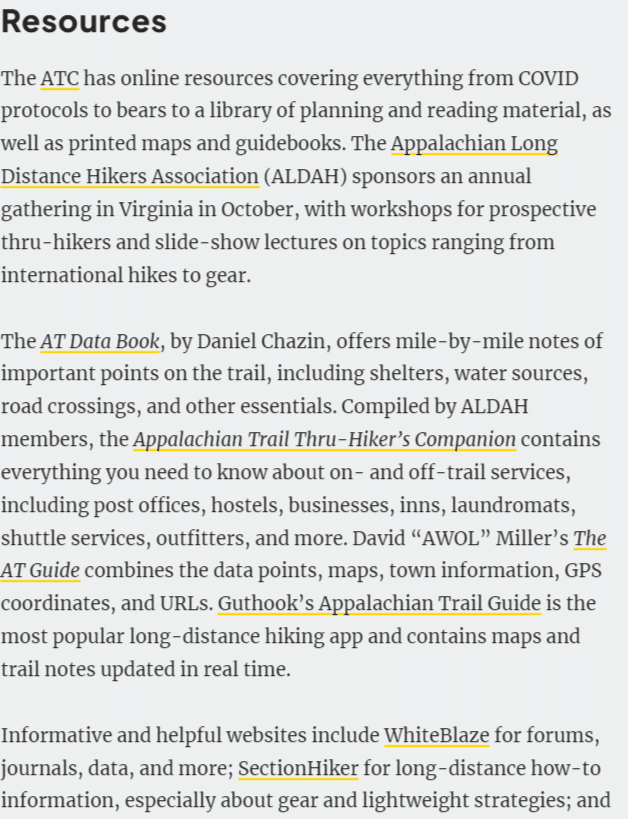
Definitive guide to influencer marketing
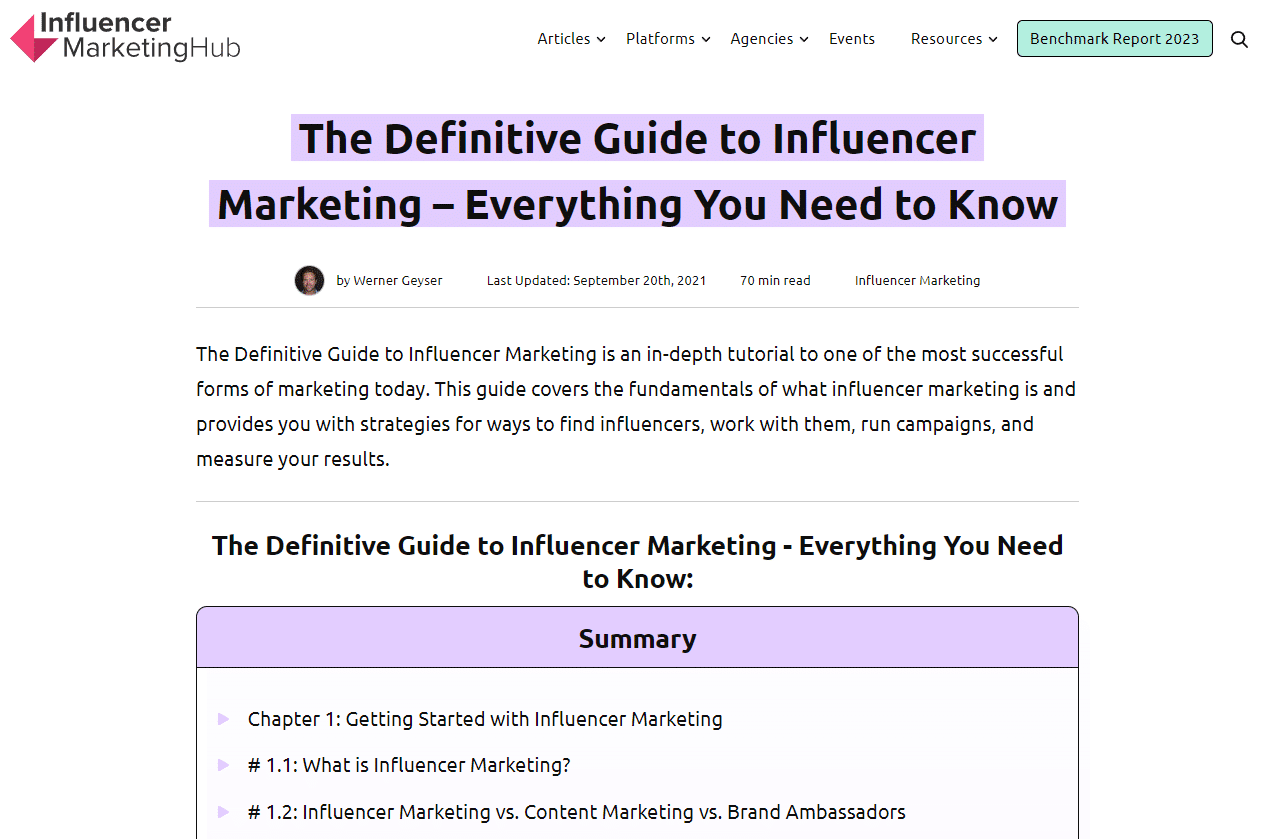
This ultimate guide will teach you every facet of influencer marketing – including the how, the what and the why.
It's super comprehensive and is broken down into chapters like "Getting Started with Influencer Marketing" and "How to Work with Influencers."
Cooking mushrooms guide
This guide is a great example of delving deep into a specific topic. The author breaks down 15 types of mushrooms, how they taste, and how to cook them for delicious results.
The kinds you've heard of – button mushrooms and shiitakes – are included, as well as ones you've probably never seen before, like black trumpet mushrooms or lion's mane mushrooms.
Financial planning guide
This financial planning guide is a great example of what I like to call "overview" content.
This type of guide provides an introduction to a topic for beginners. It helps them understand what something is, its importance, and how to get started.
This guide doesn't go deep but gives newbies the basics they need to understand the topic and eventually dive in deeper.
Tech stack guide
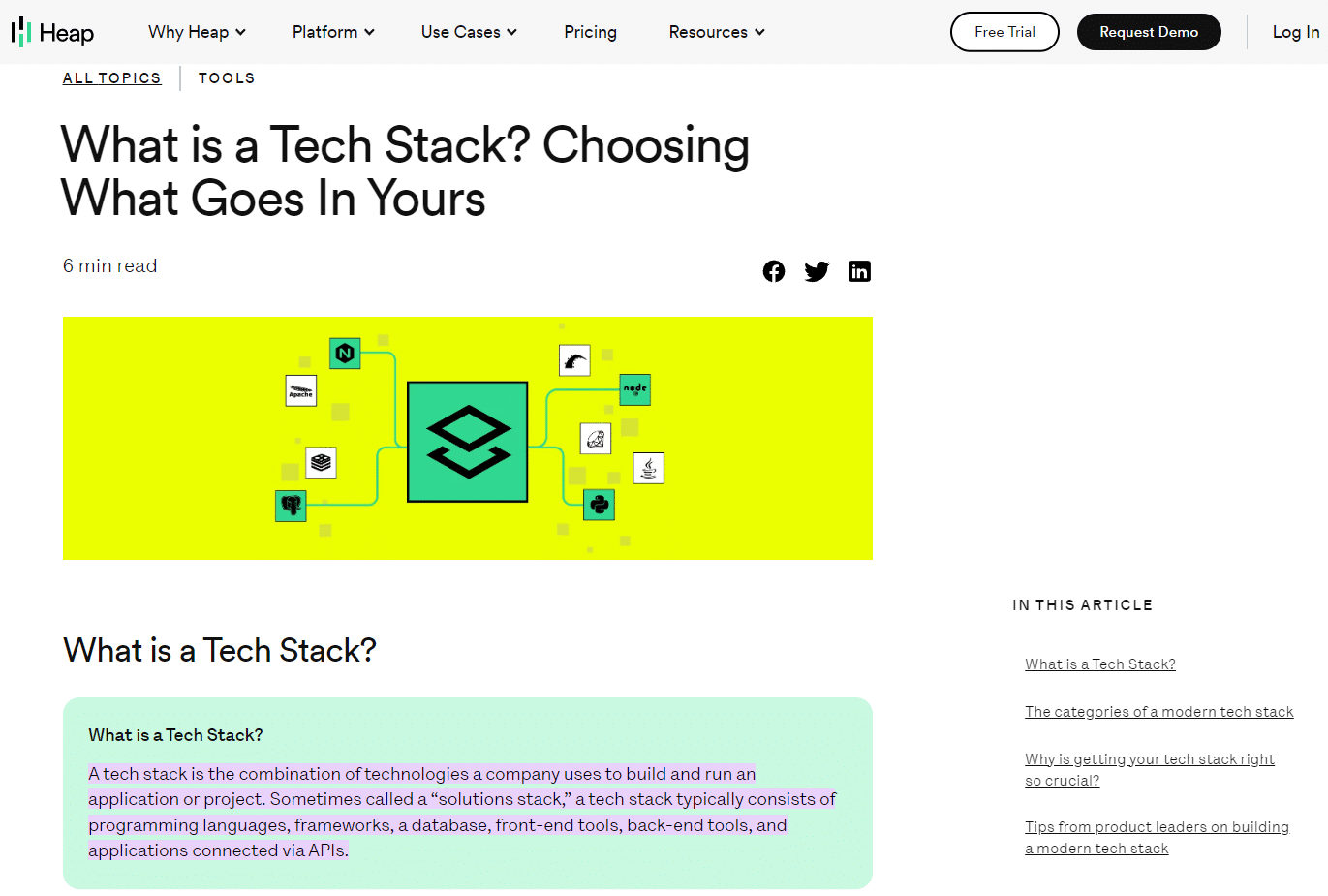
This tech stack guide's audience is software companies, so the content is framed for that audience's particular needs and problems.
It also uses vocabulary that the average person won't understand but the average software company staffer or founder will.
Create useful guides to nurture your audience
Creating a guide can be a huge undertaking, but it's worth it.
A useful guide will earn more than search traffic if optimized correctly – it will also bring in and build connections with people who need the information you're offering.
Provide helpful, readable, educational, and useful information, and your guide just might become the turning point in someone's experience of a topic.
That's powerful and can lead to greater things like growing your audience and, thus, growing your business.
The post How to create a guide that is optimized, useful and comprehensive appeared first on Search Engine Land.
from Search Engine Land https://ift.tt/z9W6wOQ
via https://ift.tt/5PNfhiI https://ift.tt/z9W6wOQ
Zero Shadow Day In Bengaluru On Tuesday: Meaning, History And Significance
Lookback: Google launched the Penguin algorithm update 11 years ago
It’s been 11 years since Google launched one of its most significant algorithm updates, Penguin. Here, we’re looking back over more than a decade of Penguin.
Find everything you want to know about Google’s Penguin algorithm update – what it is, why it was launched and its impact – plus Search Engine Land’s coverage of Penguin from 2012 to 2021.
What was the Google Penguin update?
The Google Penguin update was an algorithm update launched on April 24, 2012, to combat webspam techniques. Penguin’s primary focus was link building, keyword stuffing and general webspam.
The war against webspam wasn’t new as Penguin followed the Panda and Page Layout algorithm updates.
All of these updates had a common goal – to reward high-quality content and sites in search that provided a great user experience and fulfilled search intent. Penguin was an extension of these efforts.
It was thought that Penguin affected 3.1% of queries in English and around 3% of queries in German, Chinese and Arabic. To contextualize its significance, it was expected that a regular user would see the impact of Penguin in SERPs.
Penguin was a pretty big deal, and it impacted a lot of sites. What made this change frustrating for web owners and SEOs is that an algorithm change isn’t something a site owner can appeal to.
There was no quick fix to recover from Penguin. If hit, it was made clear that website administrators needed to reduce spam on their sites.
As a result, sites suffered, and some didn’t recover. Naturally, there was a question about whether or not the algorithm improved or worsened the SERPs.
Oh, I’m sure there are. Penguin & Panda were big changes, but they also improved things. Mobilegeddon was also an interesting one. It would also be fun to celebrate the first paid link, but I bet people would fight over the honor :).
— johnmu is not a chatbot yet(@JohnMu) March 25, 2022
Considering that Penguin is still highly influential in the algorithm today, it’s safe to say that it improved the SERPs, web owners, and SEOs have collectively learned what constitutes spam.
Most conscious site owners wouldn’t even need to think about the Penguin update since the webspam tactics that felt the wrath of Penguin – like keyword stuffing and link schemes – are an industry no-no.
Why was Google Penguin launched?
Before Penguin, the quantity of links was weighted in the algorithm. As a result, poor quality or spammy pages were ranking when they didn’t really deserve to.
Their rank was influenced by the quantity of links pointing to the site rather than the quality of the site or the content itself.
If quantity is the only factor, then it’s easy to manipulate. You just need links and lots of them.
To help us understand what constituted spam, Google shared examples of spammy pages with keyword stuffing and poor uses of links.

If link quantity mattered, then links like the above were useful to websites.
But it’s clear that the linked text has nothing to do with the article’s content. Plus, the link text reads very unnaturally within the context of the article.
If it’s not an engaging and helpful read, the content shouldn’t be ranking at all.
The link tactic demonstrated above is a black-hat SEO tactic executed solely to manipulate SERPs.
Penguin was designed to identify and demote websites that were engaging in these spammy link building tactics, while rewarding websites that had natural and high-quality links pointing to their well-researched and well-written content.
Why did Google name it Penguin?
Despite being named Penguin by Google, there doesn’t seem to be a known story about why it’s called Penguin, unlike the Panda algorithm, which was named after a key engineer. But it was the second major new Google algorithm named after a black and white animal.
Google Penguin algorithm explained: How it worked
If you want to recover from Penguin or understand how Penguin fits into the wider guidelines and algorithms it helps to understand how it worked.
Penguin was a webspam algorithm
There's a bit to unpack here.
Penguin was a webspam algorithm, meaning it impacted all sites across the web at around the same time.
Sites were crawled and new algorithm factors were taken into account. The intention of this algorithm was for high-quality sites following Google guidelines to be prioritized.
The Penguin algorithm was launched to combat spammy sites. To do this, the algorithm needs to consider many factors, including spam links and content.
Perhaps it was the timing of the Penguin update – after Panda and before the Disavow Tool – that has Penguin heavily associated with spam links and link farms, but truthfully, Penguin was more than that.
As Google's John Mueller put it:
"The Penguin algorithm is a webspam algorithm and we try to take a variety of webspam issues into account…It does also take into account links from spammy sites or unnatural links in general…but I wouldn't only focus on links. A lot of times what we see is that when a website has been spamming links maybe they're also doing some other things that are kinda borderline or against our webmaster guidelines. I wouldn't only focus on links, I'd make sure that you're cleaning all of the webspam issues as completely as possible."
Penguin ignores spam links and considers individual pages and entire sites
When Penguin launched, one of its purposes was to devalue links, taking spam links weighting out of the algorithm. However, it's thought that the Penguin algorithm can do more than just that.
In the video, Mueller says:
"When we can recognize that something is problematic and kind of a spammy link we will try to ignore it. Across a website if we see a very strong pattern there, then our algorithms can say, ‘We really have lost trust in this website…’ We need to be more on a conservative site when it comes to understanding this website's content and ranking it in the search results and then you can see a drop in visibility."
Recovering from Penguin
Recovering from Penguin was no easy feat for SEOs. There were long delays between updates which were incredibly frustrating.
As an algorithm update, the only way out was a lot of hard work, cleaning a site of its spam, which for many was no easy feat.
Google forms
For sites that had previously been flagged as spam by Google, there used to be a reconsideration request where webmasters could request a second view of their site.
This was useful in the case of a manual action, meaning a person had spotted an issue and manually marked it as spam.
But, Penguin was an algorithm change. Google announced that reconsideration requests wouldn't work if a site has suffered since the Penguin update.
Instead, webmasters had to reduce the spam on their sites. Once done, they'd eventually recover from Penguin and appear in SERPs again.
That said, there seemed to be some acknowledgment that sites were impacted by Penguin unfairly.
Google released a form where webmasters could flag this issue to Google. This same form could also be used to report sites that should've been penalized.
Clean spammy backlinks
Since Penguin was launched to fight spam with a primary focus on link spam, one strategy to recover from Penguin was the disavow tool launched on October 16, 2012.
In 2012, Matt Cutts explained how and when to use the tool.
It's important to note that this tool was not designed for most websites but for that 3% of sites using spammy links, manipulating SERPs and using link farms.
If you follow the guidelines and create content consciously, you won't need the disavow tool.
Remove on-page spam
Earlier, I shared an image of a spammy article linking to payday loans unnaturally from an article about exercising. This is the sort of spam that webmasters needed to remove from their sites.
Other on-page spam might include keyword stuffing. The thing to remember is that Google wants to prioritize content that is useful to readers.
So, before publishing content, ask yourself: is this informative? Do I meet search intent? Is this content helpful?
Although some of these guidelines were set or improved upon more than 10 years ago with the Penguin algorithm update, you might note that these items are still prevalent today.
Does Google still use Penguin?
Yes, Google still uses Penguin as part of the core algorithm.
Mueller shares tips and insights on what a site owner should do if their site is flagged as spam.
As you can see, this video is very similar to the video published by Cutts 10 years ago.
Mueller recommends the webmaster forums and advises you not to hide anything about your website.
A complete timeline of the Google Panda Updates
Here's Search Engine Land's coverage of Penguin, from 2012 to 2021:
April 24, 2012: Penguin Update 1.0
Google Launches "Penguin Update" Targeting Webspam In Search Results
April 25, 2012
Did Penguin Make Google's Search Results Better Or Worse?
April 26, 2012
Penguin Update Peck Your Site By Mistake? Google's Got A Form For That
The Penguin Update: Google's Webspam Algorithm Gets Official Name
Google Penguin Update Recovery Tips & Advice
May 3, 2012
Adjusting Your SEO Strategies During Panda & Penguin
May 10, 2012
Two Weeks In, Google Talks Penguin Update, Ways To Recover & Negative SEO
May 14, 2012
5 Local Linkbuilding Ideas For The Post-Penguin/Panda Era
May 15, 2012
In Wake Of Penguin, Could You Be Sued For Linking To Others?
May 17, 2012
Google's Penguin Update Makes The Wall Street Journal
May 21, 2012
Bing Offers Advice On Google's Penguin Update: Diversify
May 26, 2012: Penguin Update 2.0
Google Releases Penguin Update 2
May 29, 2012
First Report Of Google Penguin Recovery
May 31, 2012
Google Penguin & Panda Talk Now In Coffee Shops & Elementary School
June 11, 2012
The Four Keys To Post-Penguin Directory Submission Happiness
Aug. 16, 2012
Google: Further Penguin Update "Jolts" To Come; Panda Is Smoother & Monthly
Oct. 5, 2012: Penguin Update 3.0
Google Penguin Update 3 Released, Impacts 0.3% Of English-Language Queries
The EMD Update: Like Panda & Penguin, Expect Further Refreshes To Come
Feb. 20, 2013
No, Google Hasn't Released Unannounced Penguin Updates
March 11, 2013
Google's Matt Cutts On Upcoming Penguin, Panda & Link Networks Updates
March 19, 2013
Study Finds Google's Penguin Update Getting Stricter Over Time
April 23, 2013
Risk Management for Links - How To Prepare For The Next Penguin Update
May 10, 2013
Google's Matt Cutts: Next Generation Of The Penguin Update "Few Weeks" Away
May 22, 2013:
Penguin 4, With Penguin 2.0 Generation Spam-Fighting, Is Now Live
May 23, 2013
Still Seeing Post-Penguin Web Spam In Google Results? Let Google Know
Penguin 2.0 Losers: Porn Sites, Game Sites, & Big Brands Like Dish.com & The Salvation Army
June 3, 2013
June 18, 2013
Is Link Building Dead? 3 Tips For Link Builders Post-Penguin 2.0
Oct. 4, 2013:
Penguin 5, With The Penguin 2.1 Spam-Filtering Algorithm, Is Now Live
April 8, 2014
Google's Penguin Algorithm Comes In Different Levels Of Degrees?
May 28, 2014
No, Google Says There's Been No Penguin Update
July 30, 2014
Penguin: Google's Punitive Algorithm - And A Call To Google To Fix It
Sept. 12, 2014
A Year Later, Are We Finally Going To Get A Penguin Update Refresh?
Oct. 2, 2014
Google: Penguin Refresh May Come As Early As Next Week
Oct. 19, 2014
Google Releases Penguin 3.0 -- First Penguin Update In Over A Year
Oct. 21, 2014
Google Penguin 3.0: Worldwide Rollout Still In Process, Impacting 1% Of English Queries
Nov. 4, 2014
18 Days Later, Google Penguin 3.0 Continues To Slowly Roll Out Worldwide
Dec. 1, 2014
Google: Penguin 3.0 Rollout Still Ongoing
Dec. 3, 2014
Is This The End Of The Penguin & Panda Era Shakeups And Recoveries?
Dec. 4, 2014
Was Your Site Hit By Google's Panda Or Penguin? This Flowchart May Help You Find Out.
Dec. 10, 2014
Google Says Penguin To Shift To "Continuous Updates"
Dec. 11, 2014
How Google's Penguin 3.0 Is Playing Out Across The Web
Feb. 11, 2015
Google Says There's No Whitelist To Save You From Panda Or Penguin
April 8, 2015
Google Says The Penguin & Panda Algorithms Still Require Manual Data Pushes
April 13, 2015
Google Panda & Penguin Lack Real-Time Updates, Despite Google's Past Statements
June 2, 2015
Google: We Are Working On Making The Penguin Update Happen Continuously
July 13, 2015
Google Says Penguin Refresh Months Away From Happening
Oct. 1, 2015
Google Confirms The Real Time Penguin Algorithm Is Coming Soon
Oct. 29, 2015
Google: Next Penguin Update Should Happen By End Of 2015
Nov. 17, 2015
How To Prep For The Pending Penguin Update & Ensure You're Penalty Free In 2016
Dec. 3, 2015
Google: New Penguin Algorithm Update Not Happening Until Next Year
June 23, 2016
Key takeaways from the Google AMA: RankBrain, Panda, Penguin, bots & more
Sept. 6, 2016
How many days has it been since the last Google Penguin Update?
Google: Friday's update was not due to the Penguin algorithm
Sept. 23, 2016: Penguin Update 4.0
Google updates Penguin, says it now runs in real time within the core search algorithm
Sept. 28, 2016
Google Penguin doesn't penalize for bad links - or does it?
Google says Penguin recoveries have started to roll out now
Sept. 30, 2016
Authority & link building with real-time Penguin
Oct. 10, 2016
Google Penguin looks mostly at your link source, says Google
Google labels your links, such as 'footer' or Penguin-impacted
Oct. 13, 2016
Google says Penguin 4.0 rollout now complete
Oct. 25, 2016
Penguin 4.0: Necessary and positive improvement
Oct. 27, 2016
A Penguin's Tale: Responding to the latest update
Nov. 1, 2021
Google on Penguin algorithm; aims to ignore spammy links but can lead to distrusting your site
The post Lookback: Google launched the Penguin algorithm update 11 years ago appeared first on Search Engine Land.
from Search Engine Land https://ift.tt/rOKoQLq
via https://ift.tt/5PNfhiI https://ift.tt/rOKoQLq
Maharashtra Man Stabbed to Death By Son For Beating Wife: Report
Sunday, April 23, 2023
Delivery Man, 39, Beaten To Death In Delhi's Latest Road Rage Shocker
Minor Girl Raped And Murdered In Bulandshahr, Neighbour Arrested: Cops
Male Body Found In Outer Delhi Injury Marks; Murder Suspected
Man Arrested In UP For Kidnapping, Raping 15-Year-Old Girl For 6 Months
Saturday, April 22, 2023
Farmer Killed After Being Hit By Tractor Being Driven By Brother In UP
4 Dead, 22 Injured In Truck-Bus Collision In Maharashtra's Pune
Gurugram Woman Duped Of Rs 11 Lakh On Pretext Of Work-From-Home Job: Cops
Saket Court Firing: Shooter Threatened To Kill Her Many Times, Says Lawyer
Friday, April 21, 2023
Fire Breaks Out At Delhi's Vikas Bhawan Near ITO, 4 Fire Trucks On Spot
7 Killed, Over 40 Injured After Bus Collides With Truck In UP's Ayodhya
4 Labourers Die While Cleaning Tank At Meat Plant In Punjab: Cops
Families Of Delhi Bus Conductor, Volunteer Who Died Of Covid Get Rs 1 Crore Cheques
Bing Chat gets better at news questions and minimizes no-response answers
Microsoft Bing Chat said it is now better at responding to news questions and also reduced unnecessary duplicate searches, end conversation triggers, and returning no response to queries.
News answers. Bing wrote, “We’ve taken steps to help Bing give better answers if you’re asking questions about news. Bing said we should try to ask Bing Chart “What are today’s top breaking news stories?” So I did and it gives me these stories about Theodore McCarrick, a top news item from a few days ago; a six-year-old being shot, which is a more recent news story; Clemson being a top pick for Casey Poe, also recent news and some financial advice from CNBC from 30 minutes ago.
Here is a screenshot:
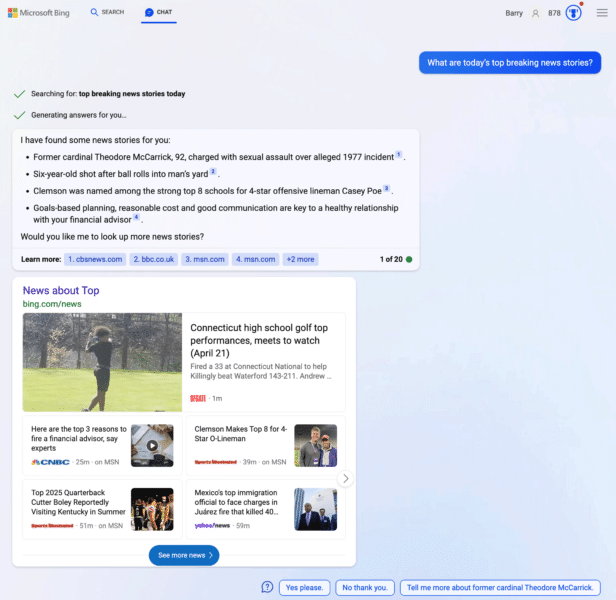
When you compare it to Google Bard, they both tell very different stories. I like how Bard breaks it down but I also prefer the top news box that Bing Chat provides:
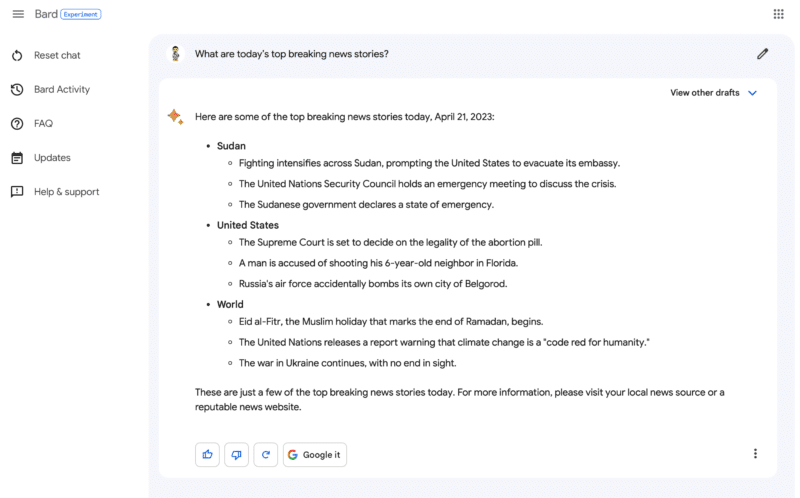
Other Bing Chat improvements. Other items Bing mentioned as updates to Bing Chat include updates to its :
- Formatting of math formulas so it is easier to read
- Reduction in how often Bing Chat triggers end-of-conversation statements
- Reduction in triggered unnecessary duplicative searches
- Minimizing errors that led to Bing chat returning no response to queries
Why we care. News publishers may be starting to notice some traffic from Bing Chat. If not, if Bing Chat grows, it may drive more and more traffic over time, as Bign Chat grows in popularity.
Plus, watching these rapid improvements to AI search and AI chat features is really exciting.
The post Bing Chat gets better at news questions and minimizes no-response answers appeared first on Search Engine Land.
from Search Engine Land https://ift.tt/UlMNOe8
via https://ift.tt/qEFjfyb https://ift.tt/UlMNOe8
"Delhi's Law And Order Creaking": AAP As Woman Shot At In Saket Court
Delhi Covid Cases "Have Sort Of Stabilised": AAP Minister
Thursday, April 20, 2023
Tigress Gives Birth To 3 Cubs In Madhya Pradesh's Gwalior Zoo
Video: 70-Year-Old Forced To Walk Barefoot To Collect Pension From Bank
Delhi Police Probing Misappropriation Of Funds Allocated To It In Budget
Power next-best action with first-party data by Cynthia Ramsaran

In today’s fiercely competitive market, delivering personalized experiences is crucial for customer engagement and loyalty. However, marketers who fail to adapt to the transition from decision-tree to trigger-based engagement strategies risk falling behind and missing out on the opportunity to captivate customers at every touchpoint with hyper-personalized experiences.
In this workshop, discover how to seamlessly collaborate with your data team to unlock the full potential of your first-party data and create personalized experiences that captivate your customers at every touchpoint.
Register and attend “How To Power Next Best Action with First-Party Customer Data,” presented by Snowplow.
Click here to view more Search Engine Land webinars.
The post Power next-best action with first-party data appeared first on Search Engine Land.
from Search Engine Land https://ift.tt/LdqNJKW
via https://ift.tt/o2VxFPq https://ift.tt/LdqNJKW